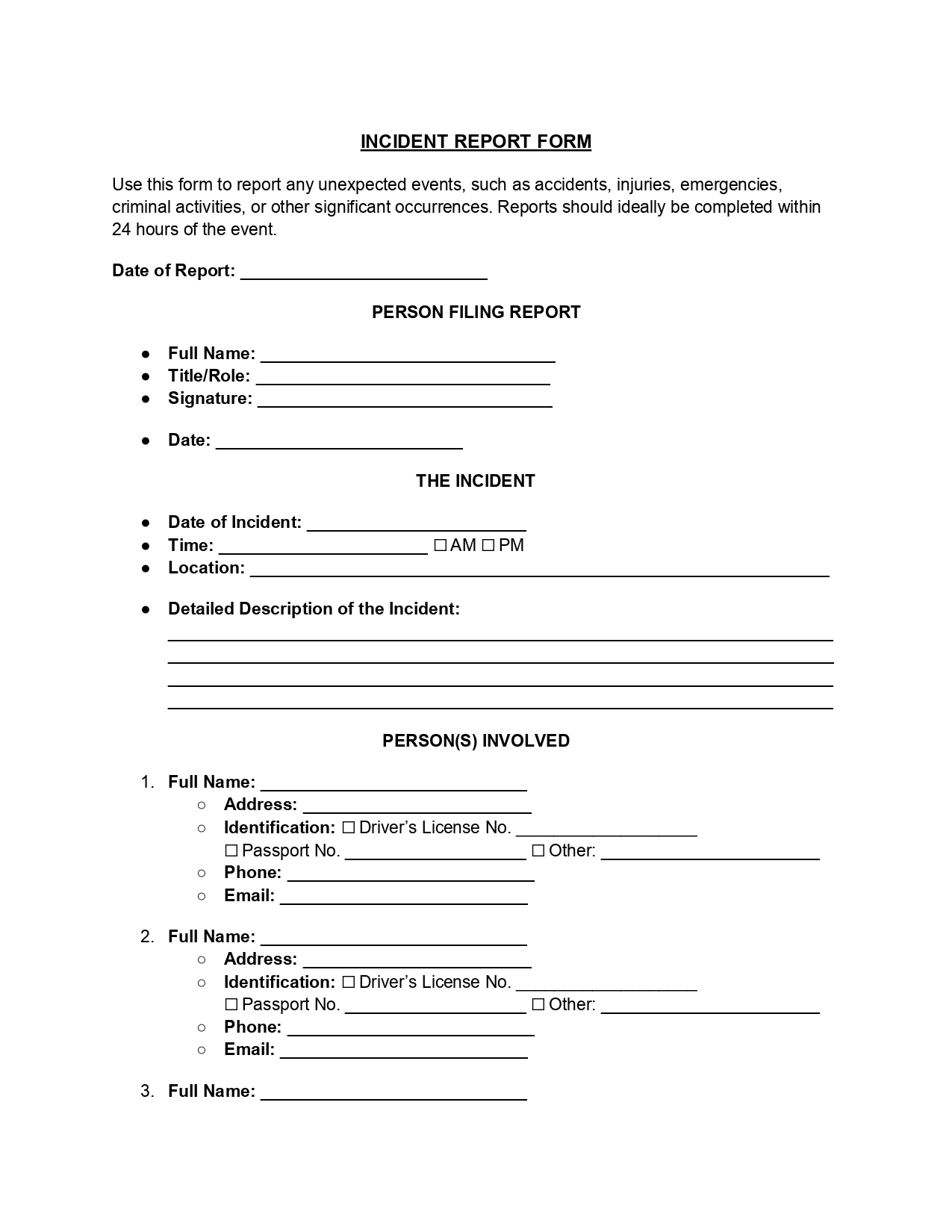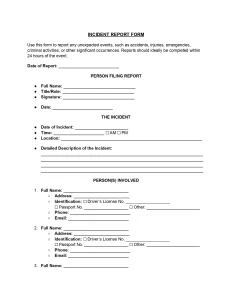Incident Report Forms
An incident report form is a document used in various settings, including workplaces, public areas, emergency services, and educational institutions. It is an official record of unexpected events or accidents, detailing the circumstances and outcomes of specific incidents. The primary function of incident reports is to capture critical data during an incident, ensuring no details are overlooked or forgotten.

Build Your Document
Answer a few simple questions to make your document in minutes
Save and Print
Save progress and finish on any device, download and print anytime
Sign and Use
Your valid, lawyer-approved document is ready
Incident Report Forms by Type
- Accident
- Employee
- Clinical
- Slip and Fall
- Critical
- Health Club
- Security
- Swimming
- Fire
- Lifeguard Accident
- Medication
- Tenant
- Near Miss
- Child Care
- Vehicle Accident
- School Accident
- Construction
- Commercial Vehicle
- Company Vehicle
- Car Accident
- Army Vehicle
- Church
- Cybersecurity (IT)
- Response (IT)
- Workplace
- Hotel Guest
- Police
- Behavior
- Summer Camp
- Property Damage
- Witness
- Truck Driver
Why Is Incident Reporting Important?
Incident reporting involves more than just following procedures. It’s a foundation for maintaining a safe and compliant business environment. By systematically documenting accidents or unforeseen events, organizations can significantly improve their security posture.
The primary reason for such detailed recording is the identification of potential hazards before they escalate into more severe problems. This approach and implementation of preventive measures effectively reduce the likelihood of similar incidents in the future. Other benefits of using these forms include:
- Risk identification. Quickly identify factors that contribute to incidents.
- Preventive action. Facilitate timely action to mitigate risk and property damage.
- Safety improvements. Continuously improve security protocols and environment.
Furthermore, reporting incidents is essential to uphold legal requirements. It offers organizations a foundation and body of evidence to show their compliance with safety regulations and due diligence. This information is crucial for internal documentation and in cases of inspections, audits, or legal matters where evidence of incident management may be needed to protect against accusations or legal actions.
Incident reports are also extremely important for gathering and analyzing data. Gathering information on accidents helps organizations identify trends and patterns, which can inform the improvement of policies and practices. This way, organizations can customize training programs, improve working conditions, and streamline operational processes.
What Are the Types of Incident Reports?
These reports can be categorized based on the nature of the issue, the environment in which the incident occurs, and the potential impact on the organization or individuals involved.
Workplace and Industry-Specific
Workplace incidents cover a range of situations, from workplace injuries to construction site problems to commercial mishaps. Each type underscores the need for stringent industry-specific safety measures and thorough documentation. Such measures are essential for physical safety and addressing workplace violence.
Transportation and Vehicles
This category includes incidents involving personal or company-owned vehicles, specifically targeting accidents, safety violations, and other related issues within the transportation sector, including truck driving and general traffic disruptions.
Security and Safety
Reports in this category cover everything from security breaches to emergencies like fires or critical incidents that require immediate attention due to their potential high impact on safety and operations.
Healthcare and Medical Treatment
These reports are critical in environments like hospitals and clinics. They document everything from patient falls to medication errors, highlighting the need for meticulous attention to patient care and medication management.
Educational and Care Facilities
Incidents in schools, daycare centers, and summer camps often involve students or children. They can range from minor injuries to behavioral issues, necessitating vigilant supervision and proactive safety protocols.
Specialized Incidents
Specialized incidents include those unique to specific fields, with examples such as cybersecurity breaches in IT, operational issues in police and military settings, or incidents within religious organizations like churches. Each requires tailored response strategies.
Miscellaneous Incidents
This broad category captures incidents like slips and falls, witness reports, and various forms of damage. It is applicable across multiple settings and emphasizes the importance of comprehensive incident documentation for investigation and response planning.
Why Use Forms for Incident Reporting Process?
Forms are very effective for managing the incident reporting process for numerous reasons. Structured forms guarantee that every critical detail is methodically documented during the incident. It encompasses information such as the time, place, people, and event description. A standardized layout is important to avoid missing important information, which is essential for evaluating and reacting effectively.
Furthermore, forms make it easier and faster for employees or witnesses to document and report incidents, simplifying paperwork. In high-speed settings, this effectiveness is critical for promptly addressing potential risks. Incident report templates help maintain a uniform data entry process, which is critical for analyzing patterns and pinpointing company improvement areas.
Another benefit of using forms is adherence to legal requirements. Several sectors enforce strict rules mandating the need for documented proof of incident response and management. An effective incident report assists in meeting legal obligations by offering precise documentation for audits, inspections, or legal matters
The Key Components of Incident Report Forms
An incident report template helps capture comprehensive details about unexpected events. The effectiveness of this document depends on several essential elements that ensure that all pertinent information is accurately recorded. Key details of an incident report form include:
- Date and time of the incident. This part specifies when the incident occurred, helping to establish a timeline and prioritize the response.
- Description of the incident. A detailed narrative of what happened, including the injuries sustained, the sequence of events, and the outcome.
- People involved. Names and roles of all individuals involved, whether directly or indirectly, which assist in subsequent investigations or legal proceedings.
- Witness statements. Witness accounts provide additional perspectives and can corroborate the details of the incident report, enhancing its accuracy and reliability.
A clear and detailed description in an incident report is essential for grasping the sequence and scope of what occurred. This section should present a factual, chronological account of the events leading up to, during, and following the accident, strictly avoiding objective language or assumptions about contributing factors. This fundamental information greatly assists in investigating the incident and devising strategies for corrective action to prevent similar occurrences.
Step-by-Step Guide to Filling Out an Incident Report Form
Complete an incident report immediately following the event to ensure witness testimonies are as accurate as possible.
1. Write the Date and Your Personal Details
Start the incident report by entering the current date at the top of the form labeled “Date of Report.” Proceed to fill in your full name, title, or role in the designated spaces under “Person Filing Report.” Ensure your signature and the date are added in the appropriate fields to validate the form.
2. Document the Incident Details
Under “The Incident,” specify the date and exact time of the incident, marking AM or PM accordingly. Provide the precise location where the incident occurred. Follow with a detailed description of the incident. This description should be a thorough and factual account of what happened before, during, and after the event.
3. Record Information About People Involved
The “Persons Involved” section lists all individuals involved in the incident. For each person, provide their full name, address, and a piece of identification (driver’s license number, passport number, or other). Also, include their phone number and email address. Repeat this for up to three individuals as the form allows.
4. Detail Any Injuries Sustained
If injuries occurred, mark “Yes” under the “Injuries” section and provide a detailed description of the injuries. This description should include the nature and extent of the injuries and who was injured.
5. Include Witness Information
If there were witnesses to the incident, mark “Yes” in the “Witnesses” section and list the details of each witness, including their full names, phone numbers, and email addresses. These persons can support the account of the incident and provide additional perspectives for analysis.
6. Notify Police and Medical Services
In this section, indicate whether the police were notified and if a report was filed. Also, specify if medical treatment was provided or refused and where it was administered: on-site, at a hospital, or elsewhere.
7. Office Use Section
The final part of the form is for administrative purposes and should be filled out by the department or relevant office personnel. They will document when the report was received and describe any follow-up actions.
